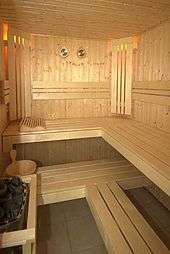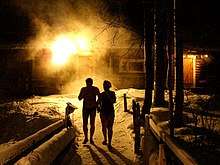Sauna
A sauna is a bathing facility where sweating in a hot room is an essential part of the cleaning procedure. The word is Finnish and the Finnish sauna is famous. There are "Finnish" saunas all around the word, some true to their name, some indeed not. There are also similar traditions in other parts of the world, such as bathing tents in many cultures, the Korean Jjimjilbang and the Roman and Turkish baths.
Sauna is used for getting clean, but very much also to relax and socialize.
Anyone elderly or with a medical condition (especially high blood pressure) should consult their physician before using a sauna. Although sauna bathing as a habit is good for the heart, you should bath more gently, and e.g. dehydration and timing of medications can be important issues.
Though sauna-bathing is traditionally done nude in groups, e.g. the Finnish do not associate saunas with sex. The international term gay sauna does however imply a venue for men looking for same-sex encounters. See LGBT travel.
Finnish sauna

| “ | If tar, liquor and sauna do not cure; the disease is fatal | ” |
—Finnish proverb | ||
The sauna is perhaps Finland's most significant contribution to the world's vocabulary. The sauna is essentially a room heated to 70–120 °C (mostly 70–90 °C, 160–190 °F). According to an oft-quoted statistic, this nation of 5 million has no less than 2 million saunas, in apartments, offices, summer cottages and even Parliament; many agreements in business and politics are reached informally after a sauna bath. In ancient times, saunas (being the cleanest places around) were the place to give birth and heal the sick, and the first building constructed when setting up a new household.
The most wholesome Finnish bathing experience might be the rantasauna ("beach sauna") which is typically a free-standing building at a lake or sheltered sea shore. Here, bathers can take turns sweating indoors, and cooling down in the water (which rarely gets warmer than 20 °C in Finland), or even ice swimming during winter.
In a snowy winter, sauna bathers can also roll around naked in the snow to wear of the heat from the sauna.
Earlier there used to be public saunas in cities, but as private saunas have gotten common also in apartments, there are only a few to be found. On the other hand, there will be one at any swimming hall and at many other facilities. The experience is not the same though, as many will use the sauna more or less just for cleaning and warmth, not for the whole ritual. If you rent a cottage, it will probably have a sauna, and many wilderness huts and similar also have one.
While titles and formalities are not important in the Finnish society, in sauna they play no role whatsoever. In the sauna all are equals: students and teachers, employer and employees, boss and subordinates.
Saunas also have some tradition in Norway and Sweden, partly owing to Finnish immigrants. The word used by Swedes (and Swedish-speaking Finns; see Finland#Talk) is bastu, making Swedish and Norwegian the only European languages without the word sauna.
How to bathe

If invited to visit a Finnish home, you may be invited to bathe in the sauna as well — this is an honour and should be treated as such, although Finns do understand that foreigners may not be keen about the idea. Enter the sauna nude after taking a shower, as wearing a bathing suit or any other clothing is considered a bit of a faux pas, although if you are feeling shy, you can wrap yourself in a bath towel. The temperature is regulated by throwing water onto the stove (kiuas): the resulting rush of heat, known as löyly, is considered the key to the sauna experience. Some sauna-goers also like to flagellate themselves with leafy branches of birch (vihta in western Finland, vasta in eastern Finland), which creates an enjoyable aroma and improves blood circulation.
Outside the family, men and women usually bathe separately; taking turns, or using separate saunas. In some companies (such as university students) men and women bathing together is common, but this should be regarded as were the family extended – and a relaxed view on nudity – not as related to promiscuity.
Depending on the occasion, the temperature in a Finnish sauna may start quite hot and gradually cool down over the hours, especially in an old wood-heated sauna. The lower benches are cooler, the corner that is the furthest away from the stove is usually the hottest place. If the heat is too much, cup your hands in front of your mouth or move down to a lower level to catch your breath. After you've had your fill, you can cool off by heading outside, just to sit at the veranda, for a roll in the snow (in winter) or for a dip in the lake (any time of the year, beach sandals or the like can be practical in the winter) — and then head back in for another round. Repeat this a few times, then cork open a cold beer, roast a sausage over a fire, and enjoy total relaxation Finnish style.
The person sitting by the stove and water bucket is responsible for throwing water at an amount and frequency keeping suitable heat. Do not take that seat by accident, as others will hesitate to question your judgement and only when the sauna is cooling down try to diplomatically ask whether it might be time to throw some more. When throwing water, beware of the hot steam, which will cause severe burns if you leave your hand or face in its way. Likewise, keep a distance to the stove itself and be careful if people are entering and leaving at the same time.
In many "public" saunas (hotels, gyms and the like), it is customary to sit on a paper towel (don't forget to take it out when leaving). Some people use a towel of their own for the purpose e.g. at swimming halls. The environment is rather hostile towards germs, so there is no need to really worry about catching a disease from the sweaty wooden bench.
In Sweden, some people wear a swimsuit in the sauna. This is frowned upon by the more orthodox Finnish sauna bathers.
Sauna is not a contest. Competing to endure the highest temperature possible, is unhealthy.
Technology
Traditional saunas may have only one room, but nowadays it is common to have three: one for undressing (sometimes also for socializing, with a fireplace, sometimes also for lodging), one for washing oneself, and the sauna proper.
These days the most common type of sauna features an electrically heated stove, which is easy to control and maintain. In the countryside wood-fired saunas are still common, but purists prefer the (now very rare) traditional chimneyless smoke saunas (savusauna), where a large pile of stones is heated and the sauna then ventilated well before entering.
Where there are electrically heated stoves, there are usually showers also. Otherwise water is typically carried from the well or lake while heating the sauna. Sea water should not be used on the stove (salt water will destroy it by corrosion). There is either a container for hot water at the stove or a separately heated hot water container. The latter will not require much firewood to get hot. When you want to wash, mix hot and cold water in a washbowl. Mix a new set or two for rinsing. The used bowls should be rinsed afterwards.
At cottages and wilderness huts, which may not have electricity (and where doing firewood may anyway be part of the vacation experience), wood heated saunas are common. People using the cottage are supposed to know how to heat it, what water to use and how to get it dry afterwards. If you intend to use such saunas, you might want to get some advice. The usual modern type will get hot in 20–60 minutes and will require adding firewood every now and then (older ones may – like the smoke sauna – be heated before only, for a longer time). Leaving the sauna for the other sex or other party with a stove without fire, or after having used all firewood or water, is rude. Tell them to wait a moment instead, for your getting more cold water. And hopefully you did leave enough hot water, an issue especially with showers with an electric warm water container, where the scarcity is less obvious.
The sauna should be dried afterwards, often by leaving the window and door open, but better with only moderate ventilation, to keep the heat inside until everything is dry. Close the door and window properly in the morning at latest. If there is still warm water, it can be used for laundry if you have such needs (wash any used washbowls well afterwards). If nobody else will come soon, you should usually empty all water containers before you leave, especially if there may be freezing temperatures.
Sauna in other countries
The sauna culture in parts of Russia is similar to the Finnish. Other variations on the theme are the North-American sweat lodge, the Turkish hamam, the Roman thermae, the Korean Jjimjilbang and the Maya temescal. Saunas are also rather popular in Germany and the liberal attitudes towards naturism (especially in the former GDR East) are similar to those in Finland. Current German chancellor Angela Merkel famously was in the sauna when the Berlin Wall came down.